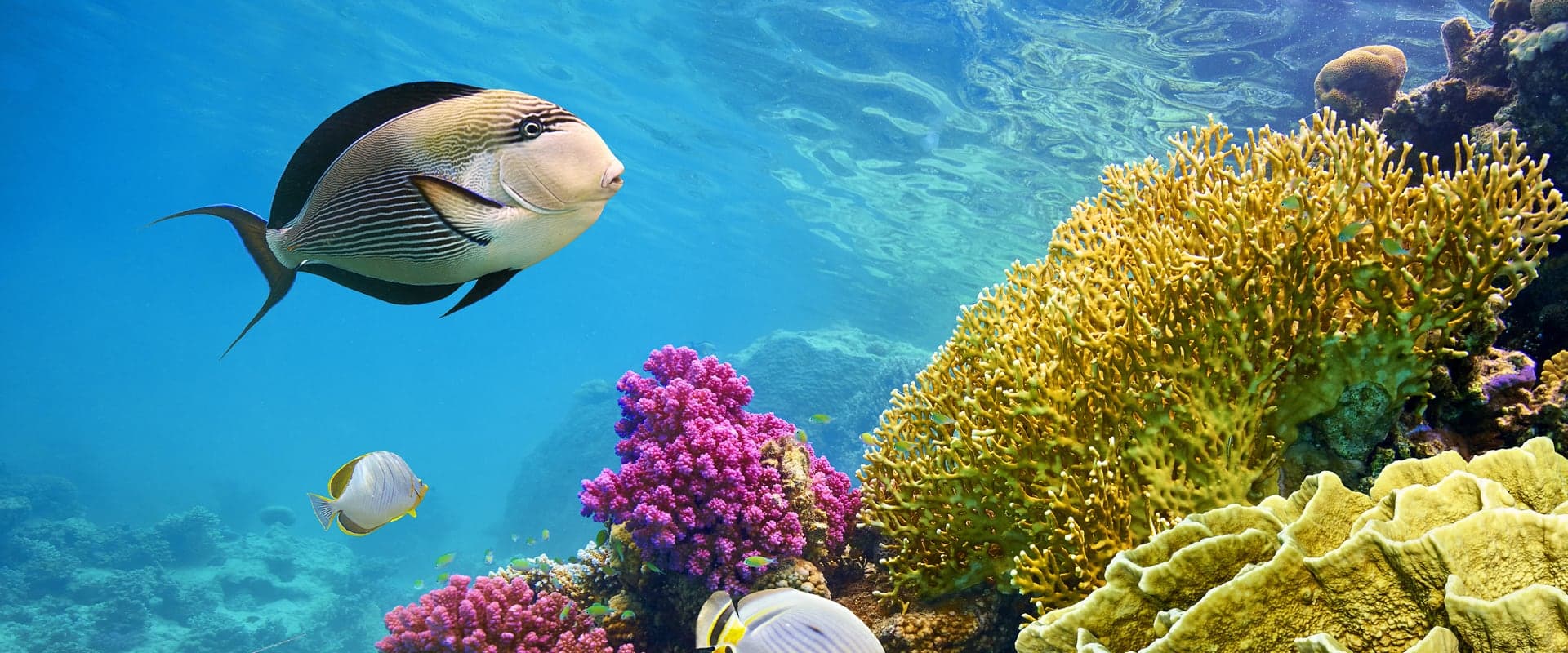Liveaboard Diving in Zabargad
What To Expect On A Zabargad Liveaboard
Liveaboards to Zabargad will usually visit here as part of a Southern Red Sea itinerary. It is one of the largest islands in the Red Sea, and offers perhaps some of the best diving. Previously thought to have been formed by volcanic activity, the island was in fact formed by extreme pressures in the mantle, created by tectonic movement. This pressure extruded rock upwards from the mantle to form a huge mountain. The tip of which only breaking through the sea after the entire lower crust was uplifted due to a collision between the African and Asiatic continental plates. The peak remains at 285 metres above sea level.
The uniqueness of how the island was formed attracted ancient miners to extract green gemstones, called peridot, from the peridotite rock. Now that mining no longer takes place, the land is relatively uninhabited with most visitors using the island as a stop off to visit Rocky Island just to the south. This, coupled with the excellent management of the Marine National Park, has created a truly special site with extraordinary offerings for divers to explore on their Zabargad liveaboard cruise.
What You Can See
Liveaboards to Zabargad Island will normally dive along its southern shore where prevailing northerly winds are blocked. The well-sheltered bay is home to green sea turtles and hawksbill turtles who use the beaches to nest during August.
Just off the southern shore, there is a small wall that drops to 50 feet (15 m), shallowing in gradient to form a gentle slope that continues to around 100 feet (30 m). From here, the reef drops off into the abyss. Visibility hovers at around 65 feet (20 m), creating excellent light conditions to see the astonishing colours of the coral and fish species in all their glory.
Upon the sandy slopes, you'll find large mounds of coral (known as pinnacles) that attract many smaller species of reef fish, including see-through glass fish, bright orange anthias and electric-blue damselfish. The pinnacles have created many overhangs, cavern areas and tantalising swim-throughs to explore. Wonderfully vibrant nudibranchs, pufferfish, scorpionfish and moray eels have also made the pinnacles their home. Octopus can even be spotted blending into their surrounding environment, changing colour and shape to match the species of coral they choose to sit on.
Swimming along the sandy tracks between the pinnacles are several larger species of fish including barracuda, humphead wrasse (better known as Napoleon wrasse), big grouper, and several types of shark. Hammerhead, oceanic whitetip and grey reef sharks can all be found at Zabargad Island. Camouflaging in the sand are imposing crocodile fish, growing up to half a meter in length, and bluespotted stingrays. Even manta rays have been spotted beyond the bays! Night diving here whilst on a Zabargad liveaboard is very popular, and many invertebrates, such as cuttlefish, octopus and squid, make an appearance.
Furthermore, to the east lies a Russian surveillance ship (known as the Russian Wreck), believed to be the Khanka, which sank in the 1970s. The wreck has been positively identified as a MOMA Class ship, but it's not yet known whether it really is the Khanka or not, due to a lack of publically available records (it is a Russian spy ship after all). Laying in just 80 feet (24 m) of water, the mast breaks the surface during low tide. Glassfish are prolific on this wreck, and it is possible to dive the engine room and bridge. Several other wrecks are rumoured to exist nearby, but the island remains relatively unexplored.
Getting There
Reaching Zabargad Island can only be achieved by Egyptian liveaboard due to the distance from the nearest ports. Liveaboards that visit Zabargad tend to depart from either Marsa Ghalib or Marsa Alam. The nearest airport is Marsa Alam International Airport, which is actually closer to the seaport of Marsa Ghalib, than that of Marsa Alam.
Zabargad Diving Reviews
- 8.9 Fabulous
- 10.0 Exceptional
- Taj H
United States
I would recommend, but if you want sharks, end of February is not the right time of year.
Diving Zabargad in February on the Blue Seas
- 9.2 Superb
- Olivier D
Belgium
Impressive island with interesting history. Be prepared for "big" encounters and sometimes drift diving
Diving Zabargad in June on the Red Sea Aggressor IV
- 10.0 Exceptional
- C James B T
Canada
Like our own private island. Superb coral. Would have done more dives
Diving Zabargad in October on the Golden Dolphin
- 8.4 Very good
- Britta B
Germany
Very nice dive in low tunnels of the reef - beautiful rock formations
Diving Zabargad in June on the Golden Dolphin III
- 10.0 Exceptional
- David D
United Kingdom
Again very good, remote site with few divers
Diving Zabargad in May on the JP Marine
- 9.6 Exceptional
- Udayan P
India
Coral gardens were relaxing
Diving Zabargad in April on the JP Marine
- 10.0 Exceptional
- Maruán K
Spain
We saw a hammerhead really close to the reef
Diving Zabargad in April on the Alia
- 8.4 Very good
- Chun L
Hong Kong
Interesting underwater terrain.
Diving Zabargad in October on the Tala
- 6.0 Review score
- kristoffer G
Denmark
okay for small stuff and general fish
Diving Zabargad in July on the JP Marine
- 8.0 Very good
- Silke K
Germany
turtles for breakfast dive
Diving Zabargad in May on the Discovery I











